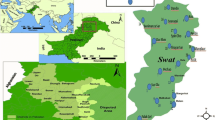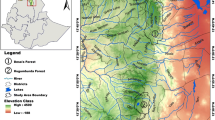Abstract
The quality of diameter measurements for natural old-growth forest was evaluated by comparing repeated field measurements in a diameter census and tree-ring chronologies. The diameter census was repeated three times from 1973 at 10- to 19-year intervals in old-growth Cryptomeria japonica forests on Yakushima Island, Japan. The diameter growth in the three intervals between (1) first and second measurement (15–19 years), (2) second and third measurement (10–13 years), and (3) first and third measurement (28–30 years) were calculated. The diameter growth of each interval was also measured using tree-ring chronologies as a control. There were significant differences in paired t tests for diameter growth calculated from the diameter census data and from the tree-ring chronologies when the interval was <20 years. Conversely, no significant differences were observed when the measurement interval was >27 years. The average percentage differences (APDs) were relatively high for every interval and for all diameter classes, but the APDs for the 28- to 30-year intervals were better than the 10- to 19-year intervals. The APDs followed a rising trend with increasing diameter at breast height for every interval. In conclusion, data from an interval of >27 years is required for accurate estimation of diameter growth. Furthermore, extra care should be taken when measuring large diameter trees. The results from this study demonstrated the difficulty of using a diameter census in natural old-growth forest.





Similar content being viewed by others
References
Barker JR, Bollman M, Ringold PL, Sackinger J, Cline SP (2002) Evaluation of metric precision for a riparian forest survey. Environ Monit Assess 75:51–72
Biondi F (1999) Comparing tree-ring chronologies and repeated timber inventories as forest monitoring tools. Ecol Appl 9:216–227
Clark JS, Wolosin M, Dietze M, Ibáñez I, LaDeau S, Welsh M, Kloeppel B (2007) Tree growth inference and prediction from diameter censuses and ring widths. Ecol Appl 17:1942–1953
Furuono T, Sawabe O (1994) Wood science series 2: anatomy and material. Kaiseisha, Otsu, p 190 (in Japanese)
Harmon ME, Ferrell WK, Franklin JF (1990) Effects on carbon storage of conversion on old-growth forests to young forests. Science 247:699–702
Holmes RL (1983) Computer-assisted quality control in tree-ring dating and measurement. Tree-Ring Bull 43:69–78
Itaka S, Yoshida S, Mizoue N, Ota T, Takashima A, Kajisa T (2013a) Identifying dendroecological growth releases in old-growth Cryptomeria japonica forest on Yakushima Island, Japan. J For Plan 19:9–16
Itaka S, Yoshida S, Mizoue N, Ota T, Takashima A, Kajisa T, Yasue K (2013b) Estimation of growth rates based on tree-ring analysis of Cryptomeria japonica on Yakushima Island, Japan. J For Plan 19:1–7
Kanetani S, Yoshimaru H (2007) Nature and history of Yakushima Island. In: Kanetani S, Yoshimaru H (eds) Aspect of forest in Yakushima. Bun-ich, Tokyo, pp 11–25 (in Japanese)
Kitahara F, Mizoue N, Yoshida S (2009) Evaluation of data quality in Japanese national forest inventory. Environ Monit Assess 159:331–340
Kitahara F, Mizoue N, Yoshida S (2010) Effects of training for inexperienced surveyors on data quality of tree diameter and height measurements. Silva Renn 44:657–667
Kyushu Regional Forest Office/Yaku-shima Environment Conservation Centre (1996) Forest of Yaku-shima. Shukosya, Fukuoka (in Japanese)
Lapin M (2005) Old-growth forests: a literature review of the characteristics of eastern North American forests. Vermont Natural Resources Council, New York
Lorimer CG, Frelich LE (1989) A methodology for estimating canopy disturbance frequency and intensity in dense temperate forests. Can J For Res 19:651–663
Luyssaert S, Schulze E-D, Bömer A, Knohl A, Hessenmöller D, Law BE, Ciais P, Grace J (2008) Old-growth forests as global carbon sinks. Nature 455:213–215
Mäkinen A, Kangas A, Nurmi M (2012) Using cost-plus-loss analysis to define optimal forest inventory interval and forest inventory accuracy. Silva Fenn 46:211–226
Matsuzaki J, Masumori M, Tange T (2006) Stem phototropism of trees: a possible significant factor in determining stem inclination on forest slopes. Ann Bot 98:573–581
Matsuzaki J, Masumori M, Tange T (2007) Phototropic bending of non-elongating and redially growing woody stems results from asymmetrical xylem formation. Plant Cell Environ 30:646–653
Miyawaki A (1980) Vegetation of Japan Yakushima. Shibundo, Tokyo, p 376 (in Japanese)
Nakamura T, Yoshida M (2000) Woody plant and gravity. Biol Sci Space 14:123–131
Pastur GM, Lencinas MV, Cellini JM, Mundo I (2007) Diameter growth: can live trees decrease? Forestry 80:83–88
Spies TA, Franklin JF (1996) The diversity and maintenance of old-growth forests. Biodiversity in managed landscapes: theory and practice. Oxford University Press, New York, pp 296–314
Stephenson NL, Das AJ, Condit R, Russo SE, Baker PJ, Beckman NG, Coomes DA, Lines ER, Morris WK, Rüger N, Alvarez E, Blundo C, Bunyavejchewin S, Chuyong G, Davies SJ, Duque A, Ewango CN, Flores O, Franklin JF, Grau HR, Hao Z, Harmon ME, Hubbell SP, Kenfack D, Lin Y, Makana JR, Malizia A, Malizia LR, Pabst RJ, Pongpattananurak N, Su SH, Sun IF, Tan S, Thomas D, Mantgem PJ, Wang X, Wiser SK, Zavala MA (2014) Rate of tree carbon accumulation increases continuously with tree size. Nature 507:90–93
Suzuki E, Tsukahara J (1987) Age structure and regeneration of old growth Cryptomeria japonica forests on Yakushima Island. Bot Mag Tokyo 100:223–241
Takahara H, Matsumoto J (2002) Climatological study of precipitation distribution in Yaku-shima Island, southern Japan. J Geogr 111:726–746 (in Japanese with English summary)
Takashima A (2009) Stand structure and dynamics of old-growth Cryptomeria japonica forest on Yakushima Island. PhD thesis, Kyushu University
Takashima A, Kume A, Yoshida S, Murakami T, Kajisa T, Mizoue N (2009) Discontinuous DBH-height relationship of Cryphomeria japonica on yakushima Island: effect of frequent typhoons on the maximum height. Ecol Res 24:1003–1011
Togo S (1981) Forest structure of natural Cryptomeria japonica forest on Yaku-shima Island. Bachelor thesis, Kagoshima University (in Japanese)
Ueda M, Yoshikawa K, Okitu J (2006) Measurement of diurnal changes in stem and branch diameters using strain gauges. J For Res 1:139–142
Vesala T, Sevanto S, Paatero P, Nikinmaa E, Perämäki M, Ala-Nissilä T, Kääriäinen J, Virtanen H, Irvne J, Grace J (2000) Do tree stem shrink and swell with the tides? Tree Physiol 20:633–635
Yoshida S, Imanaga M (1990) The stand structure and the growth of sugi (Cryptomeria japonica D. Don) natural forests on Yakushima. J Jpn For Soc 72:131–138 (in Japanese with English summary)
Zürcher E, Cantiani MG, SorbettißGuerri F, Michel D (1998) Tree stem diameters fluctuate with tide. Nature 392:665–666
Acknowledgments
Permission was obtained from Kagoshima Prefecture authorities, the Forestry Agency, and the Ministry of the Environment, Japan, for the collection of sample cores within permanent study plots located in protected areas. The present study was supported by the “Evaluation and Prediction of Effects on Forest Ecosystems in Southwestern Japan Caused by Air Pollution” project administered by the Environment Ministry of Japan and headed by S. Kanetani. We are grateful for support from the Career Center for Women Researchers at Kyushu University. We also would like to thank H. Yamada, S. Ushijima, and Y. Kawasoe for preceding research and the members of the Institute for Forest Management Laboratory (Kyushu University).
Author information
Authors and Affiliations
Corresponding author
About this article
Cite this article
Itaka, S., Yoshida, S., Mizoue, N. et al. Comparing 30-year diameter censuses and tree-ring chronologies in natural old-growth Cryptomeria japonica forest on Yakushima Island, Japan. J For Res 20, 255–262 (2015). https://doi.org/10.1007/s10310-014-0476-8
Received:
Accepted:
Published:
Issue Date:
DOI: https://doi.org/10.1007/s10310-014-0476-8




